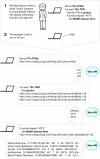The transcription factor encyclopedia
- PMID: 22458515
- PMCID: PMC3439975
- DOI: 10.1186/gb-2012-13-3-r24
The transcription factor encyclopedia
Abstract
Here we present the Transcription Factor Encyclopedia (TFe), a new web-based compendium of mini review articles on transcription factors (TFs) that is founded on the principles of open access and collaboration. Our consortium of over 100 researchers has collectively contributed over 130 mini review articles on pertinent human, mouse and rat TFs. Notable features of the TFe website include a high-quality PDF generator and web API for programmatic data retrieval. TFe aims to rapidly educate scientists about the TFs they encounter through the delivery of succinct summaries written and vetted by experts in the field. TFe is available at http://www.cisreg.ca/tfe.
Figures











References
-
- Field JK, Spandidos DA. The role of ras and myc oncogenes in human solid tumours and their relevance in diagnosis and prognosis (review). Anticancer Res. 1990;10:1–22. - PubMed
Publication types
MeSH terms
Substances
Grants and funding
- R01 DK053892/DK/NIDDK NIH HHS/United States
- CA146033/CA/NCI NIH HHS/United States
- BHF_/British Heart Foundation/United Kingdom
- R01-AI080564-01/AI/NIAID NIH HHS/United States
- R01 MH058869/MH/NIMH NIH HHS/United States
- MOP 13-147/CAPMC/ CIHR/Canada
- MOP-89806/CAPMC/ CIHR/Canada
- HL091219/HL/NHLBI NIH HHS/United States
- U01 ES017154/ES/NIEHS NIH HHS/United States
- GM079239/GM/NIGMS NIH HHS/United States
- R01GM088277-01/GM/NIGMS NIH HHS/United States
- ES11893/ES/NIEHS NIH HHS/United States
- R01CA28868/CA/NCI NIH HHS/United States
- T32GM007183/GM/NIGMS NIH HHS/United States
- WT_/Wellcome Trust/United Kingdom
- CA75123/CA/NCI NIH HHS/United States
- P50ES015903/ES/NIEHS NIH HHS/United States
- GM007377/GM/NIGMS NIH HHS/United States
- ES11863/ES/NIEHS NIH HHS/United States
- 12011/CRUK_/Cancer Research UK/United Kingdom
- R21 MH087397/MH/NIMH NIH HHS/United States
- CA45250/CA/NCI NIH HHS/United States
- ES07141/ES/NIEHS NIH HHS/United States
- ES018998/ES/NIEHS NIH HHS/United States
- R01 GM088277/GM/NIGMS NIH HHS/United States
- HD42024/HD/NICHD NIH HHS/United States
- K08 CA120349/CA/NCI NIH HHS/United States
- 1U54HG004558/HG/NHGRI NIH HHS/United States
- F32HD068113/HD/NICHD NIH HHS/United States
- R01GM084875/GM/NIGMS NIH HHS/United States
- 044215/PHS HHS/United States
- R01 GM084875/GM/NIGMS NIH HHS/United States
- MOP-84320/CAPMC/ CIHR/Canada
- R24 EY017540/EY/NEI NIH HHS/United States
- 5R01CA097226-03/CA/NCI NIH HHS/United States
- P50HL084945/HL/NHLBI NIH HHS/United States
- G0800202/MRC_/Medical Research Council/United Kingdom
- HL081205/HL/NHLBI NIH HHS/United States
- R01 HD42024/HD/NICHD NIH HHS/United States
- R01NS044262/NS/NINDS NIH HHS/United States
- P30 ES003819/ES/NIEHS NIH HHS/United States
- HL66109/HL/NHLBI NIH HHS/United States
- CA95026/CA/NCI NIH HHS/United States
- R01DK061436/DK/NIDDK NIH HHS/United States
- R01GM069417/GM/NIGMS NIH HHS/United States
- R01 NS072441/NS/NINDS NIH HHS/United States
- R01NS050386/NS/NINDS NIH HHS/United States
LinkOut - more resources
Full Text Sources
- Bern Open Repository and Information System
- BioMed Central
- Digital CSIC Spanish National Research Council - Access Free Full Text
- Europe PubMed Central
- PubMed Central
- Spiral, Imperial College Digital Repository
- Universidad Autonoma de Madrid Biblos-e Archivo
- eScholarship, University of California - Access Free Full Text
Other Literature Sources

